You may be wondering why we didn’t call this article “The Top 10 Prehistoric Swimming and Flying Dinosaurs.” Most people don’t realize that swimming or flying “dinosaurs” weren’t actually dinosaurs at all. You see, “dinosaur” is a very specific term for a particular type of animal with carefully defined characteristics. For example, to be categorized as a dinosaur, an animal’s legs must be positioned under it. However, animals like the Komodo dragon have legs extending from their sides. That’s why modern lizards are not dinosaurs, but reptiles. Simply put, dinosaurs are different from ancient reptiles. It’s a technical distinction that only really matters to some of us (paleontologists, we’re looking at you). But to head off any pedantic letters to the editor, we want to get our terms right! So, following are our picks of the top prehistoric swimming and flying reptiles. We hope you enjoy them!
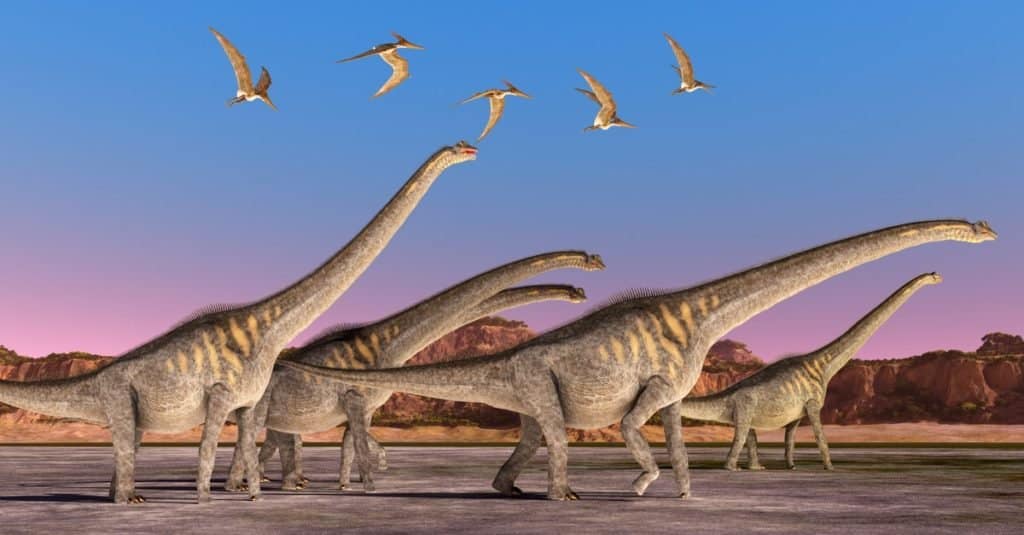
This flock of pteranodon
reptilesis flying over a herd of sauroposeidon
dinosaurs.©Catmando/Shutterstock.com
1. Quetzalcoatlus
Quetzalcoatlus lived in the Late Cretaceous period, around 70-66 million years ago. They grew up to 10 feet tall and had a wingspan of up to 36 feet. That’s the length of a standard-sized telephone pole. These big boys could weigh up to 550 pounds, about as heavy as a golf cart. They had toothless beaks they used for shoveling food down their throats, dead or alive. It’s estimated they could fly at speeds of up to 50 mph. Paleontologists think they lived in open, arid environments, where they could spot and swoop down on small animals, such as lizards, mammals, and small dinosaurs. Fossils of these giants have been unearthed in Texas and Brazil.

The quetzalcoatlus is one of the largest flying animals to have ever existed.
©Johnson Mortimer, CC BY 3.0, via Wikimedia Commons – License
2. Arambourgiania
Arambourgiania also lived in the Late Cretaceous period, around 70-66 million years ago. It was one of the largest flying animals that has ever lived on Earth. Its wingspan was about 36-43 feet. Compare that to the Hollywood Sign, in which each letter is about 49 feet tall. Can you imagine the shadow that would be cast if the “W” from that sign were flying over your yard? You’d definitely want to get the pets – and yourself – indoors! Arambourgiania also hunted prey on the ground, like amphibians, lizards, and baby dinosaurs. It may have hunted in a similar fashion to storks, only on a much bigger scale.
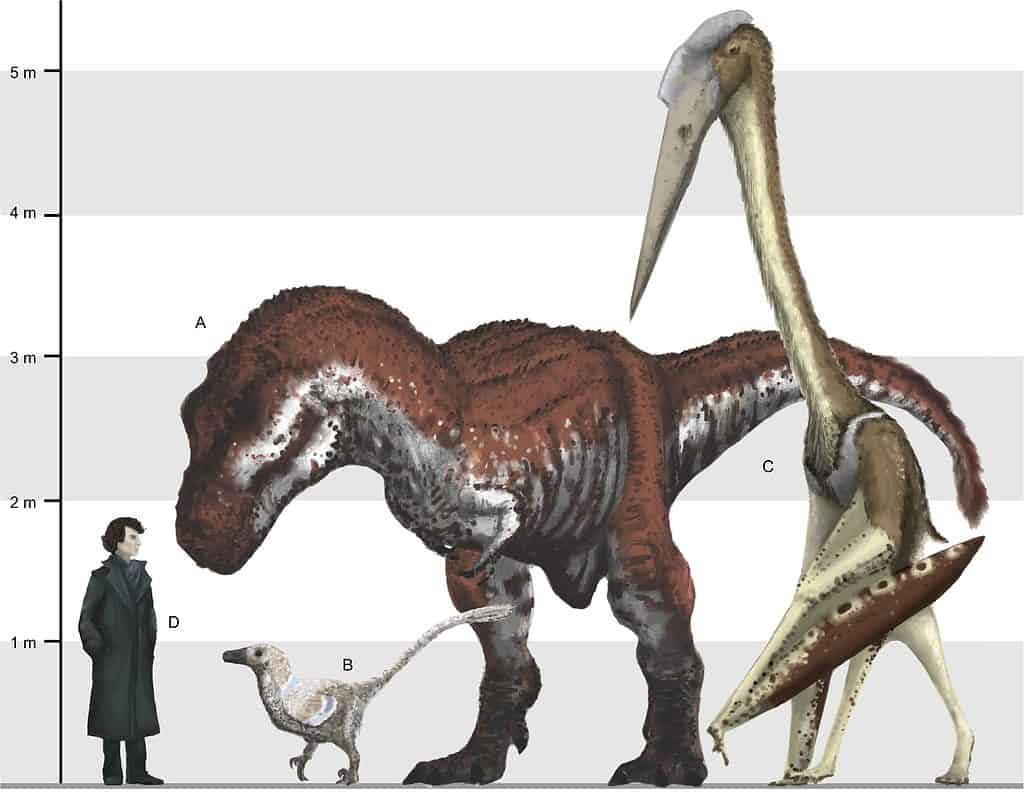
Arambourgiania had a wingspan of about 35 to 45 feet, or about as long as a yellow school bus. It stood taller than a t-rex.
©2,163 × 1,682 pixels, file size: 1.67 MB, MIME type: image/png – License
3. Liopleurodon
Liopleurodon lived in the Jurassic period, about 160-155 million years ago. It grew up to 33 feet long and weighed up to three tons, about the same as a modern rhinocerous. They had four large flippers and a long, powerful tail that helped them swim quickly in pursuit of prey. Their teeth were about 4 inches long, and they used them to feed on fish, squid, and other marine life. Fossils of Liopleurodon have been found in England and France.
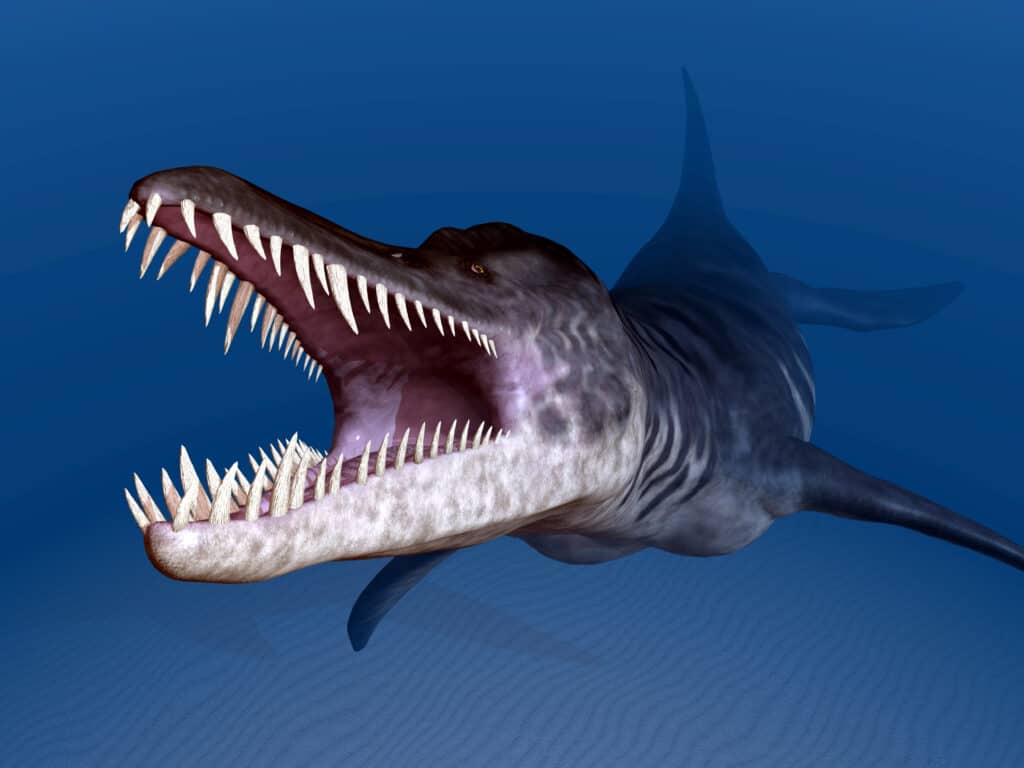
Liopleurodon was a massive carnivorous marine reptile.
©Michael Rosskothen/Shutterstock.com
4. Shastasaurus
Shastasaurus lived during the Triassic period, about 235-200 million years ago. They could grow up to 75 feet long and weighed up to 33 tons. They had four flippers and a long, pointed snout, giving them the appearance of overgrown dolphins with crocodile-like muzzles. That long mouth was full of sharp teeth in multiple rows, like that of a shark. It’s been estimated they could swim at speeds of up to 15 mph as they fled other predators or hunted down the fish and marine reptiles they ate. Their fossils have been discovered in California, Switzerland, and China.
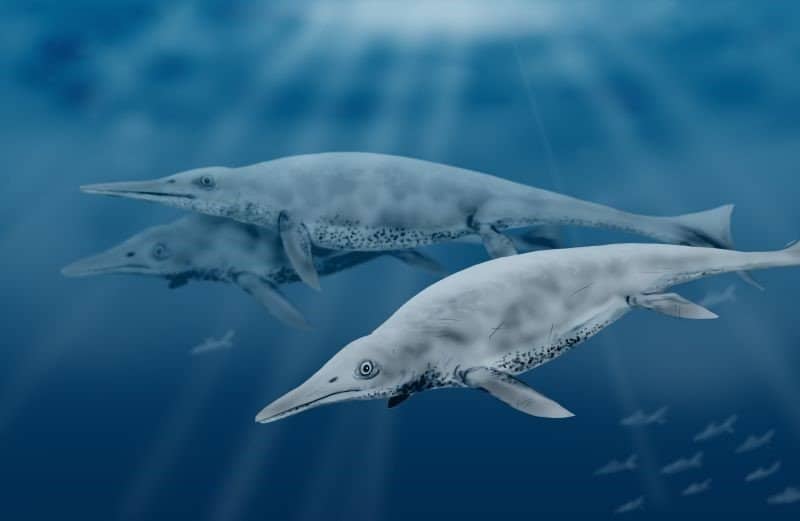
The shastasaurus looked a little like a hybrid between a dolphin and a
crocodile
, only tremendously bigger than either one.
©Nobu Tamura (http://spinops.blogspot.com) / CC BY 3.0, via Wikimedia Commons – License
5. Dakosaurus
Dakosaurus was a scary alligator-like reptile that lived in the shallow seas of the Late Jurassic period, about 150-145 million years ago. It grew up to 16 feet long and could weigh 1,300 pounds. It was an aggressive marine carnivore with a long snout full of large, serrated teeth adapted to cut through the flesh and bone of fish and marine reptiles. If you fell into the water, you’d have a hard time getting away, as they could swim up to 15 mph. Fossils of Dakosaurus have been found in England, France, Germany, and Argentina.
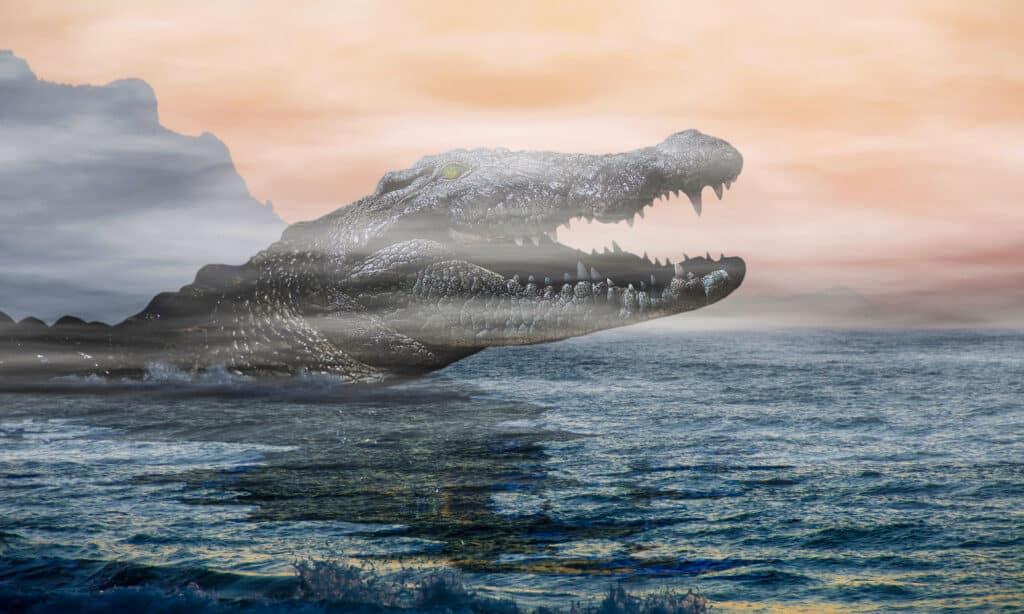
Dakosaurus was a scary alligator-like reptile that lived in the shallow seas of the Late Jurassic period.
©Artem Avetisyan/Shutterstock.com
6. Elasmosaurus
Before we say anything about elasmosaurus, we have to talk about that neck! It was extraordinarily long compared to the rest of its body and had up to 72 vertebrae. Humans, by comparison, have 33 vertebrae in our entire spinal cord, and only seven in our necks. Incidentally, giraffes also have only seven neck vertebrae, but theirs of course are much larger and longer. Modern snakes have 100-450 vertebrae in their bodies and 10-205 in their tails. So, the elasmosaurus’ neck had the range of motion and flexibility of a snake!
These ancient marine reptiles lived in the Late Cretaceous period, about 80-70 million years ago. They grew up to 49 feet long and weighed up to four tons. Additionally, they could swim a maximum of nine mph. These creatures lived in shallow seas and ate fish and other marine animals, including reptiles. Their fossils have been unearthed in Kansas, Wyoming, and California.
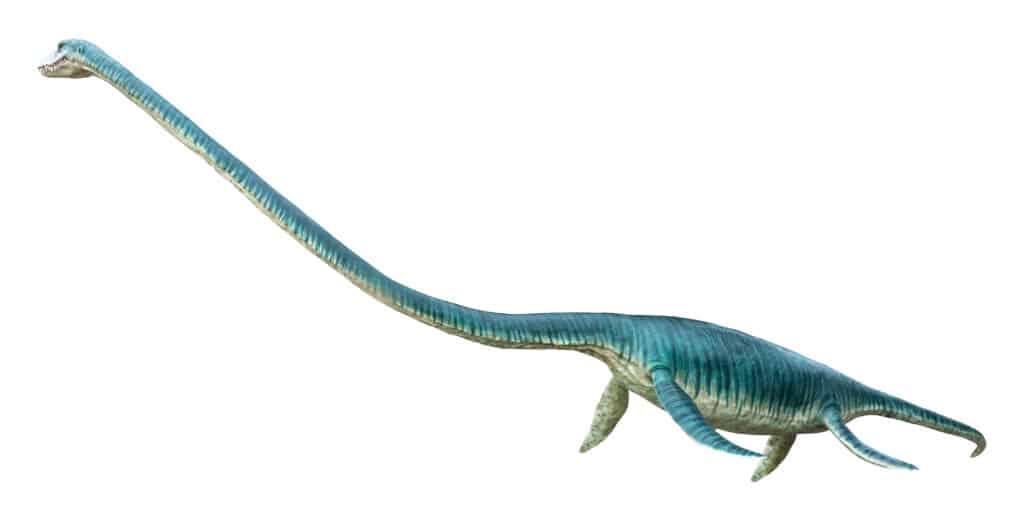
Elasmosaurus lived in the Late Cretaceous period, with its most unique feature its extremely long neck.
©YuRi Photolife/Shutterstock.com
7. Mosasaurus
You’ll remember the mosasaurus from an iconic scene in the Jurassic World movie. One of these underwater beasts was kept in a lagoon and fed sharks live for the entertainment of guests. The real-life mosasaurus lived not in the Jurassic, but the Late Cretaceous period, which was 70-66 million years ago. They got up to 59 feet long and 15 tons in weight. The mosasaurus had a long, powerful body and a streamlined head full of sharp, conical-shaped teeth. They are estimated to have been able to swim at 35 mph. Mosasaurus was a carnivore that fed on turtles, fish, and other marine reptiles. These behemoths have been uncovered in Kansas, Texas, Belgium, the Netherlands, Denmark, and Morocco, so they had quite the range in their day.
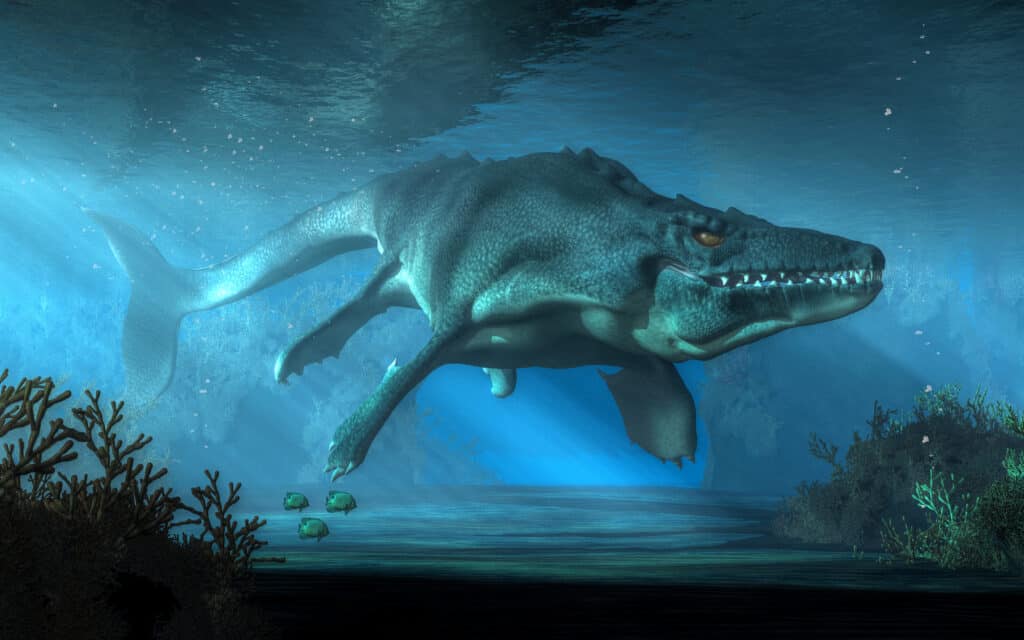
Mosasaurus was a terrifying creature that combined all the horrors of sharks and crocodiles in one monster animal!
©Daniel Eskridge/Shutterstock.com
8. Ichthyosaurus
Ichthyosaurus was a dolphin-like reptile with four flippers and a long, narrow, tooth-filled snout. It lived in the Early Jurassic period, 200-190 million years ago. Ichthyosaurus grew up to 13 feet long and could weigh about 1,100 pounds. Actually, that’s not so far off from the size of a dolphin. The largest bottlenose dolphin on record was 13.5 feet long and weighed 1,400 pounds. The ichthyosaurus could swim about 17 mph and they prowled shallow seas looking for fish, reptiles, and other small marine animals and avoiding larger predators. Their fossils have been found in Germany, England, and Switzerland.
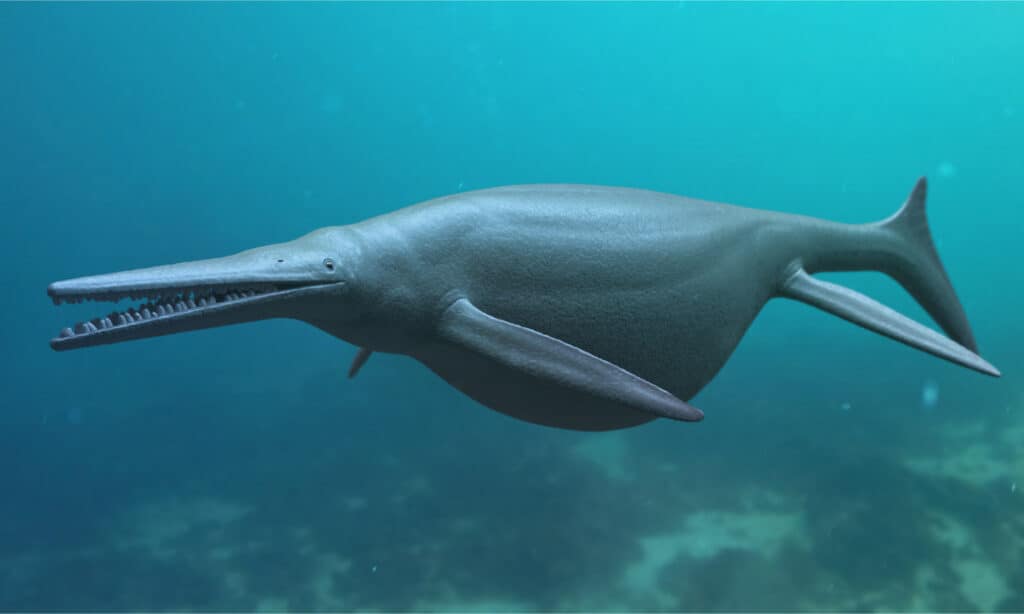
Ichthyosaurus is often compared to a dolphin or a shark though it is not related to either species.
©Giant Ichthyosaurus Aquatic Dinosaur 3D Rendered/Shutterstock.com
9. Plesiosaurus
The plesiosaurus lived from 228 million years ago to 61.6 million years ago, which placed it in the Jurassic period. While it wasn’t a dinosaur itself, it coexisted with many different species of dinosaurs. It had four fins to help it swim efficiently and a short, wide tail to help it steer itself like a rudder. Their necks were about as long as their bodies, and their total length was about 11 feet. They gave birth to live young.
The Plesiosaurus seems too small to have influenced the “Loch Ness Monster” legends, but there are those who believe these animals are one and the same. Nearly a thousand fossils of this species have been discovered in England. Depending on your feelings about the Loch Ness Monster, this is either encouraging (England is so close to Scotland!) or aggravating (it only lends more fuel to those who promote the legend).
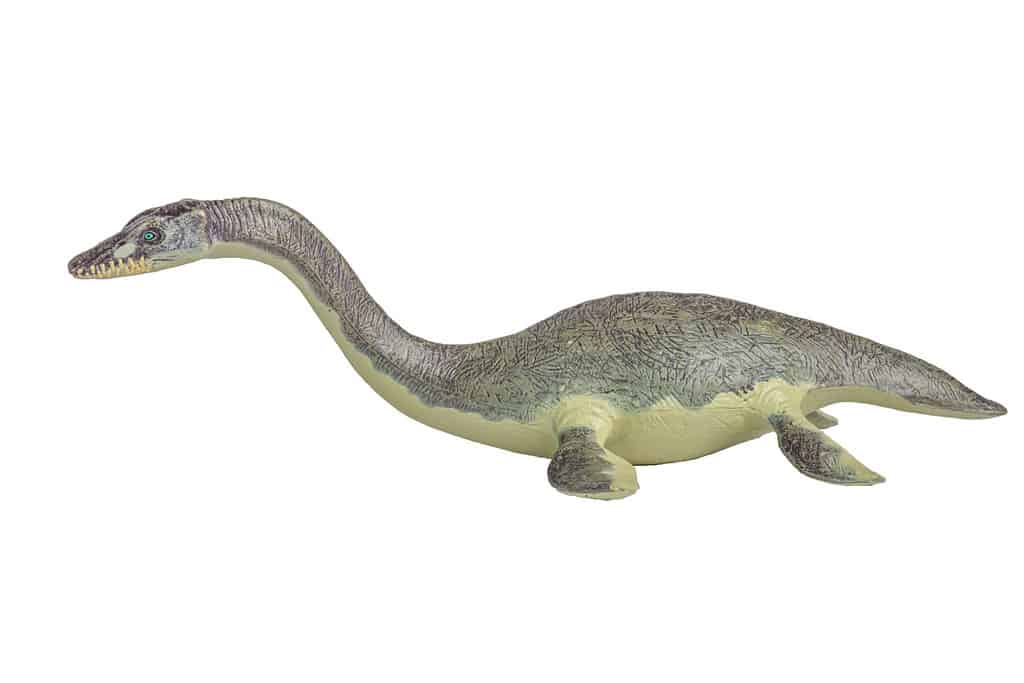
Plesiosaurus is the species the Loch Ness Monster legend was based upon.
©Fabrizio Chiriu/Shutterstock.com
10. Nothosaurus
Nothosaurus is a particularly interesting prehistoric marine reptile. It lived both on land and in water. In fact, it has sometimes been called the “seal” of the Triassic period, which was 252-201 million years ago. It would have likely spent much of its time sunning itself on the coast and diving into the water when it got hungry.
Spending time on land was a helpful survival mechanism for this 23-foot-long reptile. By venturing out of the water, it could escape marine predators. Alternatively, it could avoid land predators by jumping into the water. With the help of its webbed feet and streamlined tail, it could swim rapidly. Unusually, it had long outward-pointing teeth that intertwined like the two halves of a Venus flytrap to capture prey. They helped it hold on to squirming fish and other marine life that might try to slip away. It likely ate small dinosaurs and reptiles as well when it could catch them.
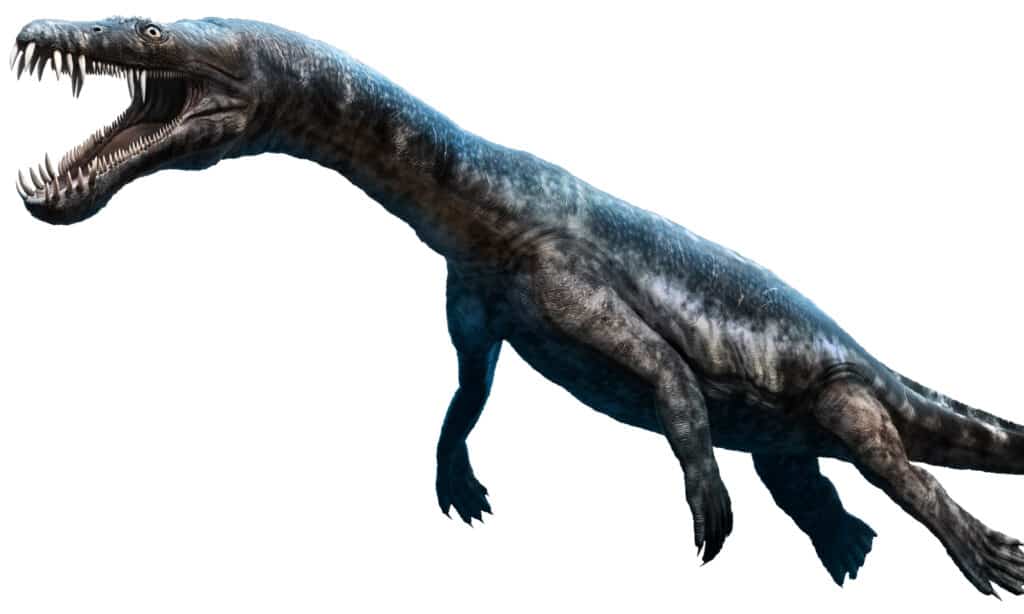
Nothosaurus lived similarly to seals today, hunting in water but coming up to breathe.
©Warpaint/Shutterstock.com
Summary of the Top 10 Prehistoric Swimming and Flying Reptiles
Here are the Top 10 Prehistoric Swimming and Flying Reptiles:
| Rank | Reptiles |
|---|---|
| 1 | Quetzalcoatlus |
| 2 | Arambourgiania |
| 3 | Liopleurodon |
| 4 | Shastasaurus |
| 5 | Dakosaurus |
| 6 | Elasmosaurus |
| 7 | Mosasaurus |
| 8 | Ichthyosaurus |
| 9 | Plesiosaurus |
| 10 | Nothosaurus |
Stay Indoors!
Can you imagine what life would be like for us today if these enormous carnivores had survived to the present day? Would you even want to leave your house if a giant flying reptile could carry you off? Would you ever get into a lake or ocean if you – and maybe even your boat – could be eaten by a giant swimming carnivore? Even though it is interesting to imagine what they looked like, we’re certainly glad that they’re gone. And as we know from the movies, bringing them back is a really, really bad idea!
The photo featured at the top of this post is © Catmando/Shutterstock.com
Thank you for reading! Have some feedback for us? Contact the AZ Animals editorial team.






